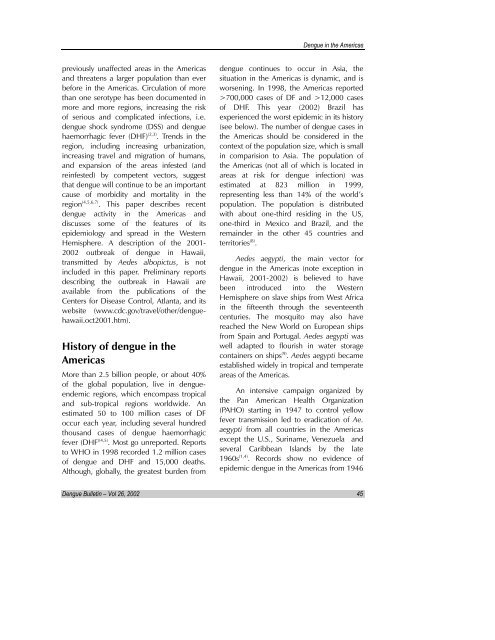Dengue Bulletin
Dengue Bulletin
Dengue Bulletin
- TAGS
- dengue
- bulletin
- 203.90.70.117
You also want an ePaper? Increase the reach of your titles
YUMPU automatically turns print PDFs into web optimized ePapers that Google loves.
previously unaffected areas in the Americas<br />
and threatens a larger population than ever<br />
before in the Americas. Circulation of more<br />
than one serotype has been documented in<br />
more and more regions, increasing the risk<br />
of serious and complicated infections, i.e.<br />
dengue shock syndrome (DSS) and dengue<br />
haemorrhagic fever (DHF) (2,3) . Trends in the<br />
region, including increasing urbanization,<br />
increasing travel and migration of humans,<br />
and expansion of the areas infested (and<br />
reinfested) by competent vectors, suggest<br />
that dengue will continue to be an important<br />
cause of morbidity and mortality in the<br />
region (4,5,6,7) . This paper describes recent<br />
dengue activity in the Americas and<br />
discusses some of the features of its<br />
epidemiology and spread in the Western<br />
Hemisphere. A description of the 2001-<br />
2002 outbreak of dengue in Hawaii,<br />
transmitted by Aedes albopictus, is not<br />
included in this paper. Preliminary reports<br />
describing the outbreak in Hawaii are<br />
available from the publications of the<br />
Centers for Disease Control, Atlanta, and its<br />
website (www.cdc.gov/travel/other/denguehawaii.oct2001.htm).<br />
History of dengue in the<br />
Americas<br />
More than 2.5 billion people, or about 40%<br />
of the global population, live in dengueendemic<br />
regions, which encompass tropical<br />
and sub-tropical regions worldwide. An<br />
estimated 50 to 100 million cases of DF<br />
occur each year, including several hundred<br />
thousand cases of dengue haemorrhagic<br />
fever (DHF )(4,5) . Most go unreported. Reports<br />
to WHO in 1998 recorded 1.2 million cases<br />
of dengue and DHF and 15,000 deaths.<br />
Although, globally, the greatest burden from<br />
<strong>Dengue</strong> in the Americas<br />
dengue continues to occur in Asia, the<br />
situation in the Americas is dynamic, and is<br />
worsening. In 1998, the Americas reported<br />
>700,000 cases of DF and >12,000 cases<br />
of DHF. This year (2002) Brazil has<br />
experienced the worst epidemic in its history<br />
(see below). The number of dengue cases in<br />
the Americas should be considered in the<br />
context of the population size, which is small<br />
in comparision to Asia. The population of<br />
the Americas (not all of which is located in<br />
areas at risk for dengue infection) was<br />
estimated at 823 million in 1999,<br />
representing less than 14% of the world’s<br />
population. The population is distributed<br />
with about one-third residing in the US,<br />
one-third in Mexico and Brazil, and the<br />
remainder in the other 45 countries and<br />
territories (8) .<br />
Aedes aegypti, the main vector for<br />
dengue in the Americas (note exception in<br />
Hawaii, 2001-2002) is believed to have<br />
been introduced into the Western<br />
Hemisphere on slave ships from West Africa<br />
in the fifteenth through the seventeenth<br />
centuries. The mosquito may also have<br />
reached the New World on European ships<br />
from Spain and Portugal. Aedes aegypti was<br />
well adapted to flourish in water storage<br />
containers on ships (9) . Aedes aegypti became<br />
established widely in tropical and temperate<br />
areas of the Americas.<br />
An intensive campaign organized by<br />
the Pan American Health Organization<br />
(PAHO) starting in 1947 to control yellow<br />
fever transmission led to eradication of Ae.<br />
aegypti from all countries in the Americas<br />
except the U.S., Suriname, Venezuela and<br />
several Caribbean Islands by the late<br />
1960s (1,4) . Records show no evidence of<br />
epidemic dengue in the Americas from 1946<br />
<strong>Dengue</strong> <strong>Bulletin</strong> – Vol 26, 2002 45









